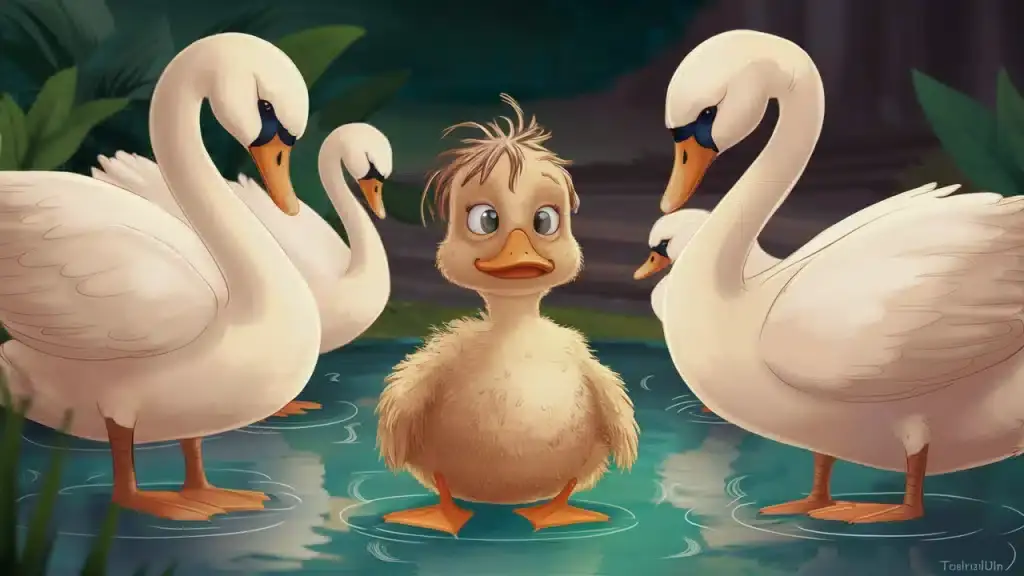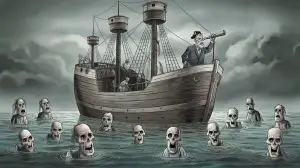The Ugly Duckling:. Imagine feeling out of place and longing for acceptance. That’s exactly what the main character in Hans Christian Andersen’s timeless fairy tale, The Ugly Duckling, experiences. This story has captured the hearts of readers for generations with its tale of transformation and self-discovery.

At its core, “The Ugly Duckling” is about finding your true self and realizing your worth despite initial struggles. The story begins with a duckling who is shunned for being different but later discovers that he is actually a beautiful swan. This powerful message of acceptance and inner beauty resonates with anyone who has ever felt like an outsider.
Set against a backdrop of vibrant characters and enchanting settings, this fairy tale by Hans Christian Andersen teaches valuable lessons about identity and belonging.
Through the journey of the so-called ugly duckling, readers are reminded that true beauty comes from within and that everyone has the potential to blossom in their own time.
Origins and Authorship
Hans Christian Andersen, a Danish author, was a master of storytelling, creating some of the most enduring fairy tales. The context of 19th century Denmark played a significant role in shaping his stories, filled with lessons and timeless themes.
Hans Christian Andersen’s Life
Hans Christian Andersen was born on April 2, 1805, in Odense, Denmark. He grew up in a poor family but showed remarkable talent for storytelling from a young age. Andersen faced many hardships, but his persistence paid off when he began writing fairy tales in his thirties.
Some of his most famous tales include The Little Mermaid, The Emperor’s New Clothes, and The Ugly Duckling. His works were often deeply personal, sometimes reflecting his struggles and feelings of being an outsider.
Andersen traveled extensively and met many influential figures of his time, including Charles Dickens. His travels inspired and enriched his writing, making his stories unique and widely appreciated. Today, Andersen is celebrated as one of the greatest fairy tale authors, with The Ugly Duckling being one of his most beloved stories.
Fairy Tales in 19th Century Denmark
The 19th century was a period of change and cultural growth in Denmark. Fairy tales like those written by Andersen were more than just children’s stories; they were a reflection of societal values and human emotions.
Andersen’s tales often featured themes of transformation, resilience, and acceptance, resonating with audiences of all ages.
In Denmark, fairy tales were a popular form of entertainment and education. Stories like The Ugly Duckling provided moral lessons wrapped in engaging narratives.
Andersen’s ability to combine simple language with profound themes made his tales timeless. His stories not only entertained but also offered wisdom that transcended the era and continues to be relevant in modern times.
Plot Overview

“The Ugly Duckling” by Hans Christian Andersen tells the story of a bird born different. Mistaken for an ugly duckling, he’s teased and bullied but eventually transforms into a beautiful swan.
An Unusual Egg Hatches
In a cozy nest, a mother duck watches over her eggs. They crack open one by one, revealing fluffy yellow ducklings. But one egg, larger than the others, takes its time.
When it finally hatches, the bird inside is big and grey. It looks nothing like its siblings.
The mother duck is puzzled but decides to raise the odd baby anyway. She introduces him to the other farm animals, but they are not kind. They rudely call him the “ugly duckling” and mock his appearance.
Struggles of the Ugly Duckling
From the start, the ugly duckling faces a harsh world. His siblings pick on him, and other animals refuse to accept him.
No matter where he goes, he’s met with cruelty. He tries to fit in but fails repeatedly.
Winter arrives, bringing cold and loneliness. The duckling hides from the biting winds and survives on little food. His isolation becomes unbearable, testing his strength and will.
Transformation into a Swan
When spring arrives, the ugly duckling emerges from his hiding place. He discovers a group of swans and, drawn by their beauty, approaches them.
Expecting rejection, he lowers his head but sees his reflection in the water—he’s become a magnificent swan.
The swans welcome him warmly, and he finally finds where he belongs. No longer ugly, he’s now admired by all.
He discovers the truth about his identity, realizing he was always a swan, just born in the wrong nest.
Characters and Settings

Hans Christian Andersen’s “The Ugly Duckling” features distinct characters and vivid settings that enrich the story. From the bustling farm to the duckling’s adventurous journey, each element adds depth and emotion to the tale.
The Farm and Its Inhabitants
The story begins on a lively farm during summertime. The main character, the Ugly Duckling, hatches here among other yellow ducklings. The farm is also home to a cat, a hen, and a farmer. The mother duck is caring and attentive, while the old woman represents a brief, hopeful refuge later in the story.
The cat and hen contribute to the poor duckling’s feelings of isolation. The cat is self-centered, full of pride, and uninterested in the duckling’s plight. The hen is bossy and dismissive, adding to the duckling’s sense of not belonging.
This farm setting, with its diverse characters, sets the stage for the duckling’s struggles and growth.
The Ugly Duckling’s Journey
After leaving the unfriendly farm, the Ugly Duckling embarks on a journey through various environments. Along the way, he experiences more rejection and loneliness. He meets different animals and faces harsh weather.
Eventually, he finds temporary shelter with an old woman who keeps him with the intent of fattening him up.
During winter, he seeks refuge in a barn and a farmer’s house, often facing harsh conditions.
In each setting, the duckling grows stronger and wiser. His journey symbolizes the search for self-acceptance and the hope for a place where he truly belongs. Finally, he discovers a lake where he transforms into a beautiful swan, finding his true home and identity.
Themes and Symbolism

Hans Christian Andersen’s “The Ugly Duckling” explores profound themes like the search for identity and the notion of beauty and acceptance. The story uses powerful symbolism to reflect personal growth and the importance of inner beauty over outward appearances.
The Search for Identity
The story’s central motif is the duckling’s journey to find out who he truly is. Born looking different from his siblings, he feels out of place.
He wanders through various environments and meets different animals, but never finds acceptance.
The duckling’s long quest symbolizes the challenges many face in finding their true selves. When he finally discovers he is a beautiful swan, it highlights the idea that our true identity isn’t always immediately apparent.
Beauty and Acceptance
The ugly duckling is ridiculed for his appearance, but the story emphasizes that true beauty is deeper than outward looks.
Other creatures mock and reject him, not realizing their own biases.
The transformation into a swan serves as a powerful metaphor for inner beauty emerging over time.
The duckling’s final acceptance by the swans reinforces the belief that finding one’s true self can lead to acceptance and love.
The heart of the message is clear: real beauty comes from within, and acceptance comes only when we embrace our true selves.
Cultural Impact

The Ugly Duckling has left a lasting mark on the world, inspiring countless retellings and adaptations. Its themes of transformation and self-acceptance resonate across different media.
Adaptations in Media
The Ugly Duckling has been adapted into various forms of media.
Walt Disney produced a charming animated short in 1939 that beautifully captured the tale’s essence. It won an Academy Award, showing just how much love people have for this story.
There are also operas, ballets, and stage plays. Each retelling brings something new, but the core message of transformation remains.
The story has also been a favorite for television and movies. Animated series and films often retell this story, making it accessible for new generations.
These adaptations continue to highlight how enduring Hans Christian Andersen’s story is.
Inspirational References
The Ugly Duckling has also sparked a plethora of inspirational references in books, speeches, and self-help guides.
The tale’s message of growing from an outcast into something beautiful is universally relatable. It speaks to anyone who has ever felt out of place, offering hope that things can change.
Authors and motivational speakers often cite the story to encourage perseverance and self-belief.
This constant inclusion in cultural discussions keeps The Ugly Duckling alive in modern times. Its ability to touch hearts and inspire confidence makes it one of the most cherished tales worldwide.
Seasonal Imagery in the Tale
Hans Christian Andersen’s “The Ugly Duckling” uses changing seasons to mirror the protagonist’s journey. The harshness of winter and the promise of spring are key elements that add depth and emotion to the story.
Spring’s Renewal
Spring arrives as a symbol of hope and transformation. The snow thaws, flowers bloom, and warmth returns.
The ugly duckling undergoes a stunning change, revealing his true self: a beautiful swan. This season represents new beginnings and the power of patience and perseverance.
Sunshine and budding life reflect his inner change and the acceptance he finally finds. This renewal brings joy and an emotional release, making the story’s conclusion deeply satisfying.
For more on the significance of these symbols, you can read an analysis of the tale.
Life Cycle of Swans and Ducks
Swans and ducks have fascinating life cycles that start from eggs and lead up to their incredible migrating journeys.
Let’s examine the key stages from hatching to flight and their migrating patterns.
Egg to Flight
Swans and ducks lay eggs in nests, usually near water. The mother lays around 4-10 eggs for ducks, and 3-8 for swans. These eggs are kept warm until hatching.
Once the eggs hatch, ducklings and cygnets (young swans) are born. From the get-go, they are covered in soft down feathers. They rely on their parents for food and protection.
A few days after hatching, they instinctively follow their mother to water.
At around 6-8 weeks, ducklings begin to grow flight feathers. Young swans take a bit longer, getting their flight feathers by 15-20 weeks.
Learning to fly is an exciting milestone. The young birds practice flapping, running, and finally taking off. By this stage, they are almost independent.
Migrating Patterns and Behaviors
Both swans and ducks are known for their remarkable migrating behaviors.
Species like the Tundra Swan migrate long distances, some even traveling from Arctic breeding grounds to warmer regions in North America.
They often migrate in V-shaped formations, which helps reduce air resistance and conserve energy. This formation signifies the unity and teamwork among the birds.
Ducks and swans have different migrating routes, but timing relies on factors like weather and availability of food sources.
During migration, they stop at wetlands and lakes to rest and refuel. These stops are crucial as they rebuild their energy reserves for the remainder of their journey.
The entire migration can take weeks or even months. Upon return, they go back to the same breeding grounds, continuing the cycle of life.
The Author’s Personal Reflections
Hans Christian Andersen often wrote from his personal experiences. In “The Ugly Duckling,” he reveals his feelings of being an outsider.
As a child, Andersen was teased for his appearance and his interests in the arts. This sense of not fitting in is mirrored in the duckling’s journey.
Andersen’s connection to royalty adds an interesting layer. He was not of noble blood but had a unique relationship with Prince Christian Frederik, who later became King Christian VIII of Denmark.
This connection could have influenced his stories of transformation and acceptance.
He also considered himself an “illegitimate son” of Danish culture, as he didn’t conform to societal norms.
This outsider status is reflected in the duckling’s struggles. The story shows that inner beauty and potential eventually lead to recognition and belonging.
Educational Takeaways
The story of “The Ugly Duckling” offers valuable insights and helps readers appreciate different perspectives.
These key points can aid in understanding and dealing with social challenges.
Lessons on Bullying and Resilience
“The Ugly Duckling” highlights the impact of bullying and how resilience can triumph over adversity.
The main character faces taunts and physical abuse because of his appearance. His journey shows how bullying can break one’s heart and spirit.
Despite being constantly ridiculed, the duckling doesn’t give up. He perseveres and eventually finds his place among the swans, reflecting the importance of staying strong and believing in oneself.
Children can learn that everyone is different and that their unique qualities are often their greatest strengths.
Understanding Different Perspectives
The story also emphasizes the value of looking at situations from different perspectives.
Initially, the other characters see the duckling as ugly and unworthy. His transformation into a beautiful swan shows that initial impressions can be misleading.
This teaches children to view others with empathy and understanding.
Reflecting on the duckling’s journey, they can see how it’s crucial not to judge others harshly based on surface appearances.
Moreover, it encourages embracing diversity and recognizing the beauty in what makes each person unique.
This perspective fosters kindness and inclusion, essential values for a harmonious society.
Steve is the creative force behind Unique Tales, a blog dedicated to sharing captivating stories that explore the human experience in all its complexity. With a passion for writing and a talent for crafting engaging narratives, Steve's blog is a treasure trove of imaginative tales that transport readers to other worlds and challenge them to see things from new perspectives. From epic adventures to intimate character studies, Steve's stories are always thought-provoking and emotionally resonant. With a growing following of readers who appreciate his unique voice and creative vision, Steve is quickly becoming a rising star in the world of online storytelling.






